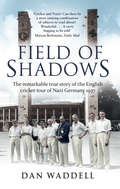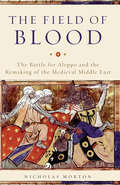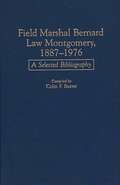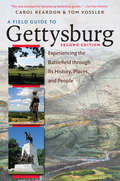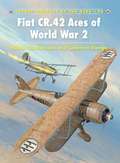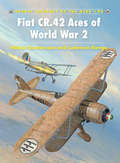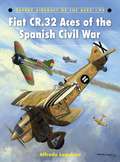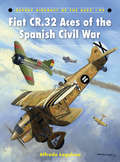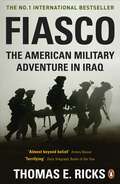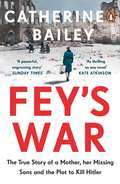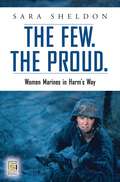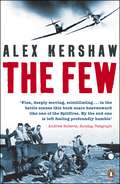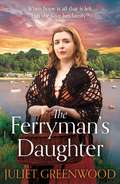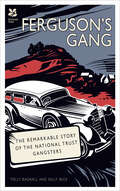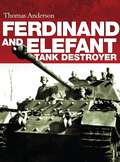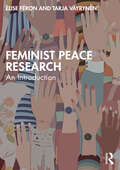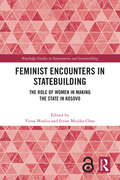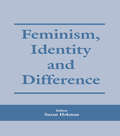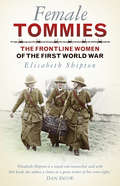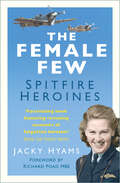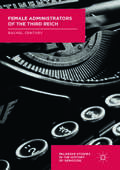- Table View
- List View
Field of Shadows: The English Cricket Tour of Nazi Germany 1937
by Dan WaddellAdolf Hitler despised cricket, considering it un-German and decadent. And Berlin in 1937 was not a time to be going against the Fuhrer’s wishes. But hot on the heels of the 1936 Olympics, an enterprising cricket fanatic of enormous bravery, Felix Menzel, somehow persuaded his Nazi leaders to invite an English team to play his motley band of part-timers.That team was the Gentlemen of Worcestershire, an ill-matched group of mavericks, minor nobility, ex-county cricketers, rich businessmen and callow schoolboys – led by former Worcestershire CC skipper Major Maurice Jewell. Ordered ‘not to lose’ by the MCC, Jewell and his men entered the 'Garden of Beasts' to play two unofficial Test matches against Germany. Against a backdrop of repression, brutality and sporadic gunfire, the Gents battled searing August heat, matting pitches, the skill and cunning of Menzel, and opponents who didn't always adhere to the laws and spirit of the game. The tour culminated in a match at the very stadium which a year before had witnessed one of sport's greatest spectacles and a sinister public display of Nazi might. Despite the shadow cast by the cataclysmic conflict that was shortly to engulf them, Dan Waddell's vivid and detailed account of the Gentlemen of Worcestershire's 1937 Berlin tour is a story of triumph: of civility over barbarity, of passion over indifference and hope over despair.
The Field of Blood: The Battle for Aleppo and the Remaking of the Medieval Middle East
by Nicholas MortonA history of the 1119 Battle of the Field of Blood, which decisively halted the momentum gained during the First Crusade and decided the fate of the Crusader statesDuring the First Crusade, Frankish armies swept across the Middle East, capturing major cities and setting up the Crusader States in the Levant. A sustained Western conquest of the region appeared utterly inevitable. Why, then, did the crusades ultimately fail?To answer this question, historian Nicholas Morton focuses on a period of bitter conflict between the Franks and their Turkish enemies, when both factions were locked in a struggle for supremacy over the city of Aleppo. For the Franks, Aleppo was key to securing dominance over the entire region. For the Turks, this was nothing less than a battle for survival--without Aleppo they would have little hope of ever repelling the European invaders. This conflict came to a head at the Battle of the Field of Blood in 1199, and the face of the Middle East was forever changed.
Field Marshal Bernard Law Montgomery, 1887-1976: A Selected Bibliography (Bibliographies of Battles and Leaders)
by Colin F. BaxterIn the desperate summer of 1942, Hitler seemed to be on the verge of victory in Russia and the Middle East. With Rommel nearing Cairo, a little known lieutenant-general, Bernard Montgomery, took charge of what Churchill called a baffled and bewildered British 8th Army. Assuming command, Montgomery issued his famous order, Here we will stand and fight;…If we can't stay here alive, then let us stay here dead, and led the Army to one of the Allies' greatest victories—El Alamein. Monty became an instantly recognizable Allied leader, but as a man with strong views, unbending principles, and outspoken frankness, he was both loved and disliked, praised and criticized. This bibliography presents and evaluates the extensive body of literature that has grown up around the controversial Field Marshal.Any serious study of World War II military campaigns must confront Field Marshal Bernard Montgomery, an individualist with both admirers and detractors. This book provides an extensive historiographical overview of the literature in Part I and a bibliography of significant works in Part II. It is a basic reference and research guide for the student, scholar, and general reader.
A Field Guide to Gettysburg, Second Edition Expanded Ebook: Experiencing the Battlefield through Its History, Places, and People
by Carol Reardon Tom VosslerThis special enhanced ebook edition to the newly updated A Field Guide to Gettysburg will lead visitors to every important site across the battlefield and also give them ways to envision the action and empathize with the soldiers involved and the local people into whose lives and lands the battle intruded.. Both Carol Reardon and Tom Vossler are themselves experienced guides who understand what visitors to Gettysburg are interested in, but they also bring the unique perspectives of a scholar and a former army officer. Divided into three day-long tours, this newly improved and expanded edition offers important historical background and context for the reader while providing answers to six key questions: What happened here? Who fought here? Who commanded here? Who fell here? Who lived here? And what did the participants have to say about it later?With new stops, maps, soldier vignettes, and illustrations, the enhanced e-book edition of A Field Guide to Gettysburg adds more human stories to an already impressive work that remains the most comprehensive guide to the events and history of this pivotal battle of the Civil War.
Fiat CR.42 Aces of World War 2 (Aircraft of the Aces)
by Richard Caruana Ludovico Slongo Håkan GustavssonThe Fiat CR.42, a logical development of the Fiat CR.32, was the last single-seat fighter biplane to be produced. It entered service with the Italian Regia Aeronautica in May 1939 before being exported to Belgium, Hungary and Sweden. Its combat debut came when the Belgian air force threw its fleet into action during the German invasion of the Low Countries on 10th May 1940. Despite being quickly overwhelmed, the Belgian pilots managed to make a number of aerial claims. The CR.42 became heavily involved in the fighting in North Africa and although it was gradually replaced by more modern fighters, it continued in a point defence and ground support role until the end of the war. Drawing on research from a range of sources, this book examines the extensive employment of the Italian fighter plane during the course of World War II.
Fiat CR.42 Aces of World War 2 (Aircraft of the Aces)
by Richard Caruana Ludovico Slongo Håkan GustavssonThe Fiat CR.42, a logical development of the Fiat CR.32, was the last single-seat fighter biplane to be produced. It entered service with the Italian Regia Aeronautica in May 1939 before being exported to Belgium, Hungary and Sweden. Its combat debut came when the Belgian air force threw its fleet into action during the German invasion of the Low Countries on 10th May 1940. Despite being quickly overwhelmed, the Belgian pilots managed to make a number of aerial claims. The CR.42 became heavily involved in the fighting in North Africa and although it was gradually replaced by more modern fighters, it continued in a point defence and ground support role until the end of the war. Drawing on research from a range of sources, this book examines the extensive employment of the Italian fighter plane during the course of World War II.
Fiat CR.32 Aces of the Spanish Civil War (Aircraft of the Aces)
by Richard Caruana Alfredo LogolusoThe CR.32 Falco was a handsome and highly manoeuvrable biplane fighter. During General Franco's fight with the Republicans for the control of Spain from 1936 – 39, no fewer than 477 CR.32s were involved, with an astounding 709 confirmed aerial victories, and an additional 320 kills claimed, for just 62 losses. As these statistics reveal, the CR.32 was the unrivalled master of the skies over Spain. By the war's end, the five leading aces of the conflict were all Spanish CR.32 pilots. Their exploits, and those of the other leading CR.32 aces, are examined for the first time in English in this exciting volume.
Fiat CR.32 Aces of the Spanish Civil War (Aircraft of the Aces #94)
by Richard Caruana Alfredo LogolusoThe CR.32 Falco was a handsome and highly manoeuvrable biplane fighter. During General Franco's fight with the Republicans for the control of Spain from 1936 – 39, no fewer than 477 CR.32s were involved, with an astounding 709 confirmed aerial victories, and an additional 320 kills claimed, for just 62 losses. As these statistics reveal, the CR.32 was the unrivalled master of the skies over Spain. By the war's end, the five leading aces of the conflict were all Spanish CR.32 pilots. Their exploits, and those of the other leading CR.32 aces, are examined for the first time in English in this exciting volume.
Fiasco: The American Military Adventure in Iraq
by Thomas E. RicksCutting through the headlines and spin, this is the first book to give us a true picture of the reality on the ground, through the words of the people there - from commanders to intelligence officers, army doctors to ordinary soldiers. Providing eye-witness accounts that contradict the official stories and figures, they give a chilling picture of the deceit, stupidity, wishful thinking, lack of forward planning and total intellectual failure of those behind the invasion. The result is an extraordinary new insight into the plight of ordinary soldiers doing nightmarish jobs, and the real nature of the fighting in Iraq.
Fey's War: The True Story of a Mother, her Missing Sons and the Plot to Kill Hitler
by Catherine Bailey**Formerly published as The Lost Boys**'As thrilling as any novel. Bailey has an extraordinary talent for bringing history to life' Kate Atkinson'Remarkable. A powerful, engrossing story of a journey into the heart of darkness and final escape from it' Sunday Times___________________________________________________________In September, 1944, the SS march into a remote Italian castle, arrest a mother and seize her two sons, aged just two and three. If Hitler has his way she will never see them again. For Fey Pirzio-Biroli is the daughter of Ulrich von Hassell, executed days before after the failed assassination of the Fuhrer. Mercilessly cast into the Nazi death machine, Fey must cling to the hope that one day she will escape and rescue her lost children . . .An extraordinary story of resistance at the heart of the Second World War, Fey's War is an illuminating and devastating true account of great personal sacrifice, of loss and, above all, of defiance.___________________________________________________________'Riveting, important, reads like a terrifying thriller' Daily Telegraph'Heartbreaking. It started with a plot to kill Hitler. It ended in one of the most astonishing and moving stories of the war' Daily Mail'Extraordinary. A rich, deep, gripping read' Guardian'As thrilling as any novel. Bailey has an extraordinary talent for bringing history to life' Kate Atkinson
The Few. The Proud.: Women Marines in Harm's Way (Praeger Security International)
by Sara SheldonOn a dark night in February 2005, Sara Sheldon arrived at Camp Fallujah, outside the dangerous ancient city for which it was named. Armed only with a camera, a laptop, and notepads, she was a spectator to the war who secured permission to embed with the 1st MEF and observe and interview Marines who happened to be women then posted at Camp Fallujah. In the time she spent there, Sheldon interviewed women who held ranks from corporal to colonel to gain a broad and varied perspective of the experiences representative of female Marines throughout Iraq. She reveals much about her subjects: the preconceived notions they possessed when they enlisted in the Corps, how the experience of serving in Iraq changed them, and what they ultimately took home from the battlefield.Americans are aware that women are actively serving in the armed forces, but few understand what exactly is expected of women in the military, the duties they perform, and the limitations and restrictions placed on them, especially in a combat zone. Sheldon reveals much about her subjects. In some ways, they mirrored their male counterparts. Some enlisted only for four years to receive educational benefits or for an opportunity to escape their home environment. Others made the Corps their career, serving as commissioned officers. Still others were recalled to active duty to serve with their representative Guard units. Sheldon uncovers their stories: the preconceived notions they possessed when they enlisted in the Corps, how the experience of serving in Iraq has changed them, and what they ultimately took home from the battlefield. She also sheds light on the day-to-day grind all American service personnel face in Iraq. Yet, she never loses her main focus. Far removed from the Green Zone, Sheldon and her subjects spent their days in harm's way, but she avoids a running commentary on policy. Instead, she remains committed to examining how women tasked with field duties and various missions at the lower levels of command are impacted by their experiences.
The Few: July-October 1940
by Alex KershawIn the early days of World War Two when Britain stood alone against the terror of Hitler's all-conquering Third Reich, her future hung in the balance; her defence in the hands of the Spitfires and Hurricanes of the Royal Air Force's Fighter Command. They were Churchill's Few. In defiance of their own country's strict neutrality laws, a handful of American adventurers flew with them. This is their story - and a fresh perspective on the greatest air battle the world has ever seen.
The Ferryman's Daughter: The gripping new family saga of strength, family and hope for fans of Josephine Cox and Sheila Newberry
by Juliet GreenwoodCan Hester help her family escape desperate poverty and fulfil her dreams?1908: Hester always loved her mother best, her father had always been a hard man to like, spending more time (and money) in the local than with his family. After her mother's sudden death, followed by an injury forcing her father to give up his job as the ferryman, Hester is placed in the position of care-giver for her young brother and sister. As the years pass Hester must row the ferry night and day to keep them all from starvation, while her hopes of working in a kitchen and one day becoming a cook, slip further and further away. But just how far is Hester willing to go to make her dream a reality? And as the threat of war comes ever closer to the Cornish coast, will it bring opportunities or despair for Hester and her family?
Ferguson's Gang
by Polly Bagnall Sally Beck1927. Britain’s heritage is vanishing. Beautiful landscapes are being bulldozed. Historic buildings are being blown up. Stonehenge is collapsing.
Ferdinand and Elefant Tank Destroyer (General Military Ser.)
by Thomas AndersonThis is the story of the largest and statistically most successful tank destroyer of World War II. The Ferdinand was a true behemoth, and although only 91 examples were built, they took a savage toll of Soviet armour in the Battle of Kursk and subsequent operations on the Eastern Front. This study explores the technical development and combat deployment of this remarkable vehicle, from its' origins in the Porsche Tiger Tank through its deployment under the designation 'Ferdinand' in the Citadel offensive, to its modification and redesignation as the 'Elefant' and final use in the desperate Battle of Berlin. Drawing on original archival material from within Germany, private collections and heretofore unpublished photographs this title is an essential illustrated history to one of the most famous armoured vehicles ever built.
Ferdinand and Elefant Tank Destroyer
by Thomas AndersonThis is the story of the largest and statistically most successful tank destroyer of World War II. The Ferdinand was a true behemoth, and although only 91 examples were built, they took a savage toll of Soviet armour in the Battle of Kursk and subsequent operations on the Eastern Front. This study explores the technical development and combat deployment of this remarkable vehicle, from its' origins in the Porsche Tiger Tank through its deployment under the designation 'Ferdinand' in the Citadel offensive, to its modification and redesignation as the 'Elefant' and final use in the desperate Battle of Berlin. Drawing on original archival material from within Germany, private collections and heretofore unpublished photographs this title is an essential illustrated history to one of the most famous armoured vehicles ever built.
Feminist Peace Research: An Introduction
by Élise Féron Tarja VäyrynenThis textbook provides a comprehensive overview of the field of gender, feminism and peace.It is based on the argument that feminist thinking is necessary to understand and analyse the core issues in peace and conflict studies and is fundamental to thinking about solutions to global problems and to promoting peaceful conflict transformation. The book centres alternative and critical approaches missing in mainstream peace research and brings forward feminist perspectives on traditional peace research topics such as militarism, peacekeeping, arms trade and the articulation of different forms of violence. It also advances critical and alternative issues and topics that traditional peace research has sidelined, including, for example, artificial intelligence, technologies and peace; trauma and memory; human–non-human species relations; art; popular culture; post-colonial and decolonial feminist perspectives; and the queering of war and peace. In sum, this textbook contributes to the visibility of these feminist critical approaches to peace research and makes them accessible to scholars and students interested in the subject.This book will be of much interest to students of peace studies, feminist theory, gender studies and International Relations.
Feminist Peace Research: An Introduction
by Élise Féron Tarja VäyrynenThis textbook provides a comprehensive overview of the field of gender, feminism and peace.It is based on the argument that feminist thinking is necessary to understand and analyse the core issues in peace and conflict studies and is fundamental to thinking about solutions to global problems and to promoting peaceful conflict transformation. The book centres alternative and critical approaches missing in mainstream peace research and brings forward feminist perspectives on traditional peace research topics such as militarism, peacekeeping, arms trade and the articulation of different forms of violence. It also advances critical and alternative issues and topics that traditional peace research has sidelined, including, for example, artificial intelligence, technologies and peace; trauma and memory; human–non-human species relations; art; popular culture; post-colonial and decolonial feminist perspectives; and the queering of war and peace. In sum, this textbook contributes to the visibility of these feminist critical approaches to peace research and makes them accessible to scholars and students interested in the subject.This book will be of much interest to students of peace studies, feminist theory, gender studies and International Relations.
Feminist Encounters in Statebuilding: The Role of Women in Making the State in Kosovo (Routledge Studies in Intervention and Statebuilding)
by Vjosa Musliu Itziar Mujika ChaoThis volume provides one of the first comprehensive feminist readings of international statebuilding, with a specific focus on the case of Kosovo.Rather than simply showing how the state in Kosovo is being built by and through women and feminist encounters, this volume is interested to problematise women and feminist subjectivities vis-à-vis the state and statebuilding. The book challenges three main arguments related to the processes and subjects of statebuilding in Kosovo. First, the academic literature on Kosovo has a tendency to take the international intervention of 1999 as the originary point of statebuilding processes in Kosovo. Second, and relatedly, given Kosovo's unprecedented exposure to Western intervention and statebuilding, the majority of works start from the presumption that liberal interventionism in Kosovo (and elsewhere) is normatively more progressive than the previous system, and that the liberal interventionism and statebuilding are naturally gender progressive and gender-equal. The third argument has to do with the existing legal architecture on gender and women’s rights in contemporary Kosovo. The aim of the volume is to, on the one hand, problematise the evidence against the backdrop of everyday manifestations and/or performances of statebuilding and on the other hand interrogate the co-constitutive gender aspect. In terms of methodology, the volume brings together contributions that rely on traditional and multi-sited ethnography, and narrative research rooted in projects and initiatives in Kosovo. This allows the contributors to unearth new and silenced actors, entry points, subjects and subjectivities in processes of and related to statebuilding in Kosovo; feminist frictions and challenges to statebuilding in Kosovo; as well as encounters of heteronormative statebuilding.This book will be of much interest to students of statebuilding, Balkan politics, feminisms, and international relations, in general.
Feminist Encounters in Statebuilding: The Role of Women in Making the State in Kosovo (Routledge Studies in Intervention and Statebuilding)
This volume provides one of the first comprehensive feminist readings of international statebuilding, with a specific focus on the case of Kosovo.Rather than simply showing how the state in Kosovo is being built by and through women and feminist encounters, this volume is interested to problematise women and feminist subjectivities vis-à-vis the state and statebuilding. The book challenges three main arguments related to the processes and subjects of statebuilding in Kosovo. First, the academic literature on Kosovo has a tendency to take the international intervention of 1999 as the originary point of statebuilding processes in Kosovo. Second, and relatedly, given Kosovo's unprecedented exposure to Western intervention and statebuilding, the majority of works start from the presumption that liberal interventionism in Kosovo (and elsewhere) is normatively more progressive than the previous system, and that the liberal interventionism and statebuilding are naturally gender progressive and gender-equal. The third argument has to do with the existing legal architecture on gender and women’s rights in contemporary Kosovo. The aim of the volume is to, on the one hand, problematise the evidence against the backdrop of everyday manifestations and/or performances of statebuilding and on the other hand interrogate the co-constitutive gender aspect. In terms of methodology, the volume brings together contributions that rely on traditional and multi-sited ethnography, and narrative research rooted in projects and initiatives in Kosovo. This allows the contributors to unearth new and silenced actors, entry points, subjects and subjectivities in processes of and related to statebuilding in Kosovo; feminist frictions and challenges to statebuilding in Kosovo; as well as encounters of heteronormative statebuilding.This book will be of much interest to students of statebuilding, Balkan politics, feminisms, and international relations, in general.
Feminism, Identity and Difference
by Susan HekmanThis study focuses on a set of issues at the forefront of feminist thought in the late 1990s: identity, difference and their implications for feminist politics. As feminism moves into an era in which differences among women, the multiple identities of woman and identity politics are all at the centre of feminist discussions, new approaches, methods and politics are called for.
Feminism, Identity and Difference
by Susan J. HekmanThis study focuses on a set of issues at the forefront of feminist thought in the late 1990s: identity, difference and their implications for feminist politics. As feminism moves into an era in which differences among women, the multiple identities of woman and identity politics are all at the centre of feminist discussions, new approaches, methods and politics are called for.
Female Tommies: The Frontline Women of the First World War
by Elisabeth ShiptonThis book tells the story of women in the First World War at the front line, under fire, and in combat. Through their diaries, letters and memoirs, meet the women who defied convention and followed their convictions to defend the less fortunate and fight for their country. Follow British Flora Sandes as she joins the Serbian Army and takes up a place in the rear-guard of the Iron Regiment as they retreat from the Bulgarian advance. Stow away with Dorothy Lawrence as she smuggles herself to Paris, steals a uniform and heads to the Front. Enlist in Russia’s all-female ‘Battalion of Death’ alongside peasant women and princesses alike. Through the letters, diaries and memoirs of women who were members of organisations such as the US Army Signal Corps, the Canadian Army Medical Corps, the FANY, WRAF, WRNS, WAAC and many others, we learn what life was like for them on the front and discover the courage of the women who took up arms.
The Female Few: Spitfire Heroines of the Air Transport Auxiliary
by Jacky HyamsThrough the darkest days of the Second World War, an elite group of courageous, gifted women risked their lives as courier pilots, flying Lancaster Bombers, Spitfires and many other aircraft in hundreds of perilous missions across the country. The role of these women pilots of the Air Transport Auxiliary was to deliver the planes to the male RAF pilots who would take them into battle, dangerous work which the women carried out unarmed, without radios. Fifteen would lose their lives. In The Female Few, five of these astonishingly brave women tell their stories for the first time, awe inspiring tales of incredible risk, tenacity and sacrifice. Their spirit and fearlessness in the face of death still resonates down the years, and their accounts reveal a forgotten chapter in the history of the Second World War. As Yvonne Macdonald, now 90 and living in Cape Cod, says: ‘It was a kind of freedom you never get any other way, it was as if you had wings sewn on your back. A lot of people here in Cape Cod don’t even know I was in World War Two. Or what I did.’ They do now.
Female Administrators of the Third Reich (Palgrave Studies in the History of Genocide)
by Rachel CenturyThis book compares female administrators who specifically chose to serve the Nazi cause in voluntary roles with those who took on such work as a progression of established careers. Under the Nazi regime, secretaries, SS-Helferinnen (female auxiliaries for the SS) and Nachrichtenhelferinnen des Heeres (female auxiliaries for the army) held similar jobs: taking dictation, answering telephones, sending telegrams. Yet their backgrounds and degree of commitment to Nazi ideology differed markedly. The author explores their motivations and what they knew about the true nature of their work. These women had access to information about the administration of the Holocaust and are a relatively untapped resource. Their recollections shed light on the lives, love lives, and work of their superiors, and the tasks that contributed to the displacement, deportation and death of millions. The question of how gender intersected with Nazism, repression, atrocity and genocide forms the conceptual thread of this book.
